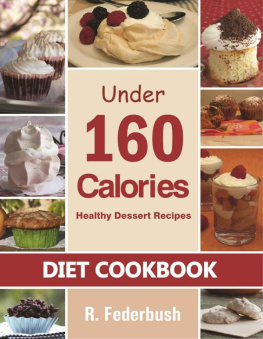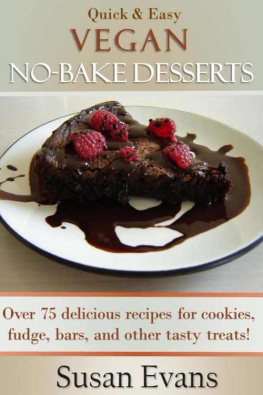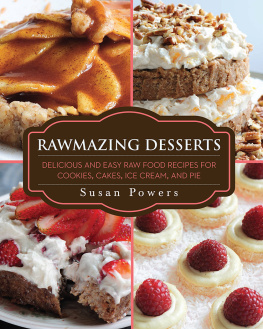



I often spend a majority of my day thinking about dessert. Luckily, its my job, which is particularly wonderful because I have been a sugar-lover for as long as I can remember. Desserts were always part of our familys meal when I was growing up. Even if my grandmother, aunt, or mom hadnt made an apple pie, berry cobbler, or a creamy baked custard, we would have a scoop of vanilla ice cream out of the freezer. These were simple desserts, but because family members took the time to make and serve them, I always felt loved and indulged. Thats whats magical about dessert. The simple act of sharing something sweet thats been made with care brings such tremendous joy.
A LOVE AFFAIR WITH DESSERT
Some of my earliest memories are of being with my grandmother in the kitchen stirring batters, dipping out flour, and snatching M&Ms while she poured them into cookie dough. All of the women in my family are wonderful cooks and particularly talented bakers. I loved watching my grandmothers handsthey were arthritic but strongand the care she took with whatever she was creating inspired me to become a good baker. She had a deft touch guided by intuition that made her desserts memorable. To this day, no one can recreate her crustless baked custard pie. She would transform the strawberries bought from roadside stands near our home in Garden Grove, California, into strawberry shortcake made with sweetened drop biscuits. She could make her signature jumbo raisin cookies without a recipe well into her 60s. My aunt was in charge of the coconut cake I usually requested for my birthdayshe finished the three-layer cake with super-thick Italian meringue icing and tons of toasted coconut. (Ive recreated a lighter version thats just as much of a showstopper on page 226.) These are the kinds of desserts that have stayed with me my whole life. These desserts, made with such love, are the ones I still crave.
Ive always enjoyed tinkering in the kitchen, but this passion didnt become my career until later in life. My first job was in banking, and then I moved into the heartfelt world of nonprofit organizations. I was an executive, and although I enjoyed the work, it became incredibly stressful. Amid all of that, there was always my love of baking. So after 25 years in the business world and thanks to an amazing, supportive husband, I decided to change careers and focus on my true love: DESSERT. My husband, Barry, and I packed up a U-Haul and moved from Visalia, California, to Hyde Park, New York, where I attended the Culinary Institute of America and received a degree in baking and pastry arts. Culinary school was
two of the most challenging and yet rewarding years of my life. My ultimate goal was to work in a test kitchen, and thats where I ended up in 2008 when I came to Cooking Light.
I started as an intern , where I did the grocery shopping and prep work for recipe testers, and organized and cleaned out the pantries. I did have a few recipes to test each week, but not the same number as the full-time testers. One of the highlights of my time as an intern was when I developed an ice cream topping that ran in the magazineI was over the moon in love with my new career. Now, I am one of those full-time recipe developers and testers. Its my job to come up with the irresistible desserts in the magazine, and its these and additional new recipes that Ive collected here in Incredibly Decadent Desserts. Ive reevaluated and retested many original recipes, too, reading online reader comments and adjusting the recipes to reflect those helpful suggestions.


MY METHODS
I have a dream job. I spend my days thinking up ideas for desserts, and then I make and test them. The initial spark of an idea might start with a memory or be inspired by something I recently tasted or read about. Its typical for me to go through a few iterations to get the dessert just right and make sure it meets Cooking Light s nutritional standards. My challenge is always to produce the same gratifying desserts you would enjoy in a bakery or a restaurant, just in a package thats 300 calories or less. Then the magazine staff tastes it and decides if it rates high enough to be published. Fortunately, this type of tinkeringusing ingredients smartly, adjusting baking times to get the perfect texture and browning, and playing with other elements to create the perfect dessertis why I love what I do.
When developing a new light dessert, I have a few tricks up my sleeve. I manage the sugar content by using assertive ingredients to wring out absolutely every bit of flavor, like high-quality vanilla extract, lemon rind, and almond paste. I use the freshest fruit at the peak of its season. I put just a dash of salt in everything, even in an eggy custard, to balance it and bring out flavors.
Saturated fat is the most difficult part to get right in any light dessert. Dessert needs the richness added by fat to have the right mouthfeelwhether its moist and cakey, or creamy, or crisp, or flaky like a piecrust. Truthfully, piecrust is one of the hardest things to make light because butter is the key to those wonderful layers. Often I substitute canola oil or egg white for some of the butter, and Ive also started using non-hydrogenated natural shortening to get those flaky layers. (It took me a long time to convince Cooking Light s dietitian to sanction it.) I also discovered that adding vinegar and baking powder helps create the right texture. And in other desserts, I like using nut flours because they deliver huge flavor without adding too much fat.
Healthier chocolate desserts are always a challenge. Chocolate itself is high in saturated fat, even though its plant-based. So I find the richest, deepest chocolate and use it in smaller amounts to keep the flavor as intense as possible. Wait until you taste the . One taste of these rich desserts will have you wondering how they can really be light.
One of my favorite ingredients for keeping light desserts creamy and fluffy is frozen whipped topping. One day Ill write a book called In Defense of Frozen Reduced-Calorie Whipped Topping, but for now, you can read a little more about my view on it on page 15. Lets just say, without it, Id be sunk.
With the resurgence of interest in ancient grains, I wanted to create recipes that included some of them, such as amaranth, teff, and Kamut flours. What I learned through developing these recipes is that you cant just substitute equal amounts of them for regular all-purpose flour. The gluten content in each is different and the flavors are bold. It took me several tries, for example, to get the just right because the flavor of amaranth is so strong and earthy that it needed to be balanced with just the right amount of all-purpose flour. In the end, I found a happy ratio. Youll find all the desserts that include whole and ancient grains are tagged throughout the book.
A FEW NOTES ON THE RECIPES
Next page














